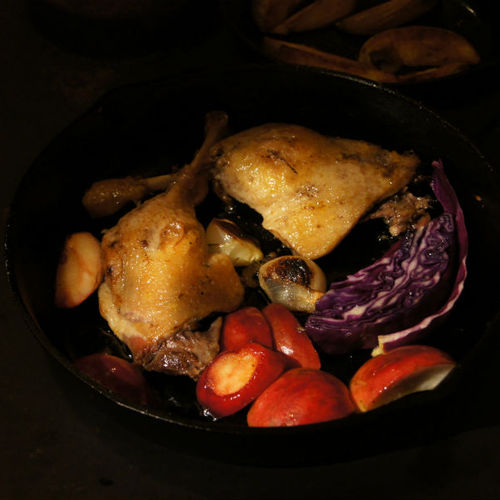Turkey is a traditional holiday meal choice. But writer Brett Laidlaw wonders if perhaps we should consider another kind of holiday fowl.
Recipe: Duck Confit
Confit was originally a method of preserving salted meat in fat; today we use the technique more for flavor than preservation, and indeed, there’s little more appetizing than a succulent leg of duck that’s been spiced, salted, and then simmered slowly in duck fat to maximum tenderness.
Making confit is not difficult, but it can be a little messy. The first thing you need is a pot of duck fat.
If you have access to a good butcher, you may be able to buy a pint or two of fat to get started. If that’s not an option, you’re going to have to get yourself a nice fatty duck or two and then proceed as follows.
Trim off all excess fat and fatty skin. Save the legs and breasts with the skin and take all the other skin off the carcass (the carcass can be used to make stock). Cut the skin and fat into roughly ½-by-3-inch strips, place them in a heavy saucepan with water to cover by an inch. Bring the pot to a boil and then simmer over medium heat. As the water boils off, the fat will render, and when the water is all gone you’ll be left with a pot of pure fat, with little cracklings of duck skin bobbing in it. Let the cracklings get nice and brown in the fat, then remove them with a slotted spoon to drain on paper towels. They’re delicious lightly salted as a cocktail nibble or sprinkled on a salad.
Now that you have a supply of fat, you can continue making your confit, as below. The hard part is over. Store the fat in a plastic container in the freezer and use it over and over. It gains character with each new confit. The fat is wonderful for frying or oven roasting root vegetables.
If you have gizzards, hearts, wings, or necks, use those in the confit, too. The giblets and shreddy meat are great on a dinner salad. You need not absolutely submerge the meat in fat as it cooks; the legs do tend to float somewhat, and you can turn them a couple of times in the cooking.
- 4 meaty duck legs, thigh and drumstick together
- ½ teaspoon quatre-épices (see below)
- Freshly ground black pepper
- 1½ teaspoons salt
- 8–10 cloves garlic
- 2 bay leaves
- 3–4 sprigs fresh thyme
- Duck fat to cover, about 4 cups
A day before you make the confit, dry the duck with paper towels, sprinkle the spice blend and salt evenly over both sides, along with a few grinds of pepper. Cover and refrigerate at least overnight and up to 3 days. Prior to cooking, drain off any accumulated juices and dry the duck with paper towels.
Preheat oven to 275 degrees. Arrange the duck in a single layer in a baking dish or heavy pot large enough to comfortably hold duck and fat. Spread the garlic, bay leaves, and thyme over the duck. Cover with melted fat. Cook, covered, for 2 to 3 hours, turning the duck once or twice. The fat will cloud as juices come off the duck; when it’s done, the fat will be clear and bubbling. The juices will settle at the bottom of the pan, and you’ll want to save them—they’re a bit salty but absolutely delicious.
Let the duck cool in the fat. Use it the same day or store, refrigerated, in the fat for a couple of weeks. The salt plus the airtight seal formed by the fat helps preserve the meat. Prior to cooking, dig out the duck and let sit at room temperature to allow excess fat to melt off.
Here are a couple of simple confit presentations:
Brown the legs in a Dutch oven, set them aside and remove all but a tablespoon or two of fat. Add some chopped onion and garlic and then some homemade sauerkraut, rinsed, drained, and squeezed dry. A little of that delicious fond from the bottom of the confit pan and just a splash of water makes a savory sauce. Simmer everything very gently. Just before serving, add back the duck and some boiled fingerling potatoes to warm.
Boil together an assortment of root vegetables—carrot, parsnip, celery root, potato—peeled and cut in chunks. Cook until tender and drain, reserving a cup of the cooking liquid. Leave a bit of confit fat in the pan, add to it a chopped leek and a couple cloves of chopped garlic. Cook until the leek is wilted, then add the vegetables and some of their cooking liquid, and mash with a fork. Season to taste with salt and pepper, and serve browned duck on top of mash.
Quatre-Épices: A classic French blend, it translates as “four spices,” but this version contains six. Use sparingly: it is potent, and a little bit gives a really exotic, appetizing aroma.
- 2 teaspoons ground coriander
- 2 teaspoons ground allspice
- 1 teaspoon ground ginger
- 1 teaspoon ground cinnamon
- 1/2 teaspoon grated nutmeg
- 1/8 teaspoon ground cloves
Combine and store in a tightly closed jar in a dark place.








